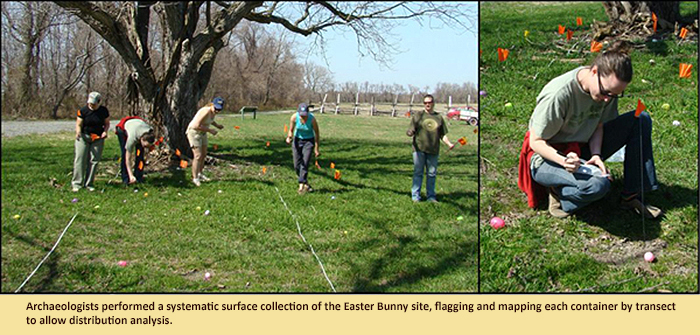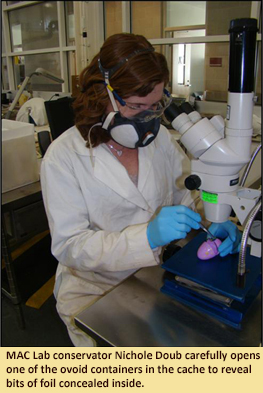The Easter Bunny Cache
April 2010
By Sara Rivers Cofield, MAC Lab Curator of Federal Collections
 On April 1st, MAC Lab archaeologists discovered a rare example of a site occupied by the mysterious Easter Bunny culture. Descriptions of Easter Bunnies abound in oral history and folklore, but they have often been dismissed as myth. Archaeology has revealed evidence of Easter Bunnies on numerous occasions, but their material culture is poorly understood because usually only one or two of the unique ovoid containers that are associated with the culture are found on any given site.
On April 1st, MAC Lab archaeologists discovered a rare example of a site occupied by the mysterious Easter Bunny culture. Descriptions of Easter Bunnies abound in oral history and folklore, but they have often been dismissed as myth. Archaeology has revealed evidence of Easter Bunnies on numerous occasions, but their material culture is poorly understood because usually only one or two of the unique ovoid containers that are associated with the culture are found on any given site.
The recently-discovered Easter Bunny cache is comprised of 16 examples of these distinctive and brightly-colored containers. "It is rare to find an intact Easter Bunny site," says Ed Chaney, Deputy Director of the MAC Lab, "they are often looted, especially by small children. That’s what makes this site so exceptional." Archaeologists conducted a systematic surface collection of the site and are confident that they have identified its boundaries and recovered all of the artifacts, including one cleverly concealed in the nook of a tree.

Some scholars suggest that these containers are stylized versions of chicken eggs, but others feel that the color and material of the containers are too different from chicken eggs to support this assertion. As Chaney points out, "If they are supposed to represent chicken eggs, then oral history would have remembered these people as the Easter Chicken culture, not the Easter Bunny culture. There is no logical connection between bunnies and eggs."
 Each container is hollowed out to allow storage of some kind. X-radiography revealed that three of the containers held several coins. One example was carefully opened by MAC Lab conservator Nichole Doub to reveal five well-preserved United States quarters. Based on the level of patina on the metal, Doub estimates that the quarters were deposited in the container at least a year ago. The dates on the coins help with determining the time of deposit by providing a terminus post quem or "TPQ" for the site, meaning that the cache must have been placed at some point after the last date on the coins, which appears to be 2007. Archaeologists believe that the money containers are offerings left by only the wealthiest portion of Easter Bunny society.
Each container is hollowed out to allow storage of some kind. X-radiography revealed that three of the containers held several coins. One example was carefully opened by MAC Lab conservator Nichole Doub to reveal five well-preserved United States quarters. Based on the level of patina on the metal, Doub estimates that the quarters were deposited in the container at least a year ago. The dates on the coins help with determining the time of deposit by providing a terminus post quem or "TPQ" for the site, meaning that the cache must have been placed at some point after the last date on the coins, which appears to be 2007. Archaeologists believe that the money containers are offerings left by only the wealthiest portion of Easter Bunny society.
Of the remaining 13 containers, seven appear to be empty and six contained only fragments of a metallic foil. Upon closer inspection, however, a residue was discovered in all 15 containers. Chemical analysis of the residue has revealed evidence of sugar storage, and the examples with the foil fragments have trace elements of cocoa as well. Although this evidence might suggest food storage activity, the practicality of using such small containers to store food is questionable, and since water may seep in at the center of the container, then sugar placed inside would be at risk of dissolving. Instead, most archaeologists agree that the containers were spread about the landscape annually by the Easter Bunny culture as part of some kind of ritual or religious offering to give thanks to unknown deities for bringing about the end of winter.
There is still much that archaeologists have yet to understand about how and why these containers were deposited at the site. For example, is there significance to the different designs, colors, and sizes? Statistical analyses are thus far inconclusive because the sample size is too small, but if more sites are discovered it may be possible to determine if certain sizes or colors are more likely to contain coins as opposed to sugar or cocoa. Archaeologists also question why some containers were left out on lawns as if meant to be found, while others were partially concealed in trees and bumpy landscape features. Despite these nagging questions, the Easter Bunny cache offers important insights into the complexity of the mysterious culture that created it. Not only did they have a hierarchical class structure where some individuals left money and others food offerings, but they also seem to have had elaborate religious rites that were tied to the seasons. The cache is currently being processed for long-term curation so that it will be available for research as more sites are found and more questions arise about the elusive Easter Bunnies.
Happy April Fools!